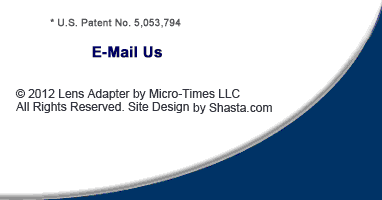In 1982 I was a consultant in the
magnetic disk industry in Silicon Valley,
Ca. and wanted to photograph different microscopic defects that were seen on
reject disks through a 3x to 400x zoom microscope. I had just purchased a SLR
camera that had automatic light metering capabilities and thought I could
document the defects with this camera by merely attaching the lens to the
eyepiece of the microscope.
I then began calling camera shops in the San Francisco area asking for a SLR
camera lens to eyepiece adapter. Much to my amazement, they told me the only
item available to take pictures through a microscope with an SLR camera was an
SLR camera body to eyepiece adapter.
They further stated I would need a camera body to eyepiece tube adapter
called a T-ring. The T-ring has a specific manufacturers camera body bayonet
connection on one end and female threads on the other end that the fixed focal
length microscope tube threads into (it should be noted that one must remove the
lens from the camera body to mount the T-ring to the body of the camera thereby
removing the automatic aperture/shutter adjusting capabilities of the SLR camera
which in turn negates the automatic picture taking capabilities of a SLR
camera).
I was further informed by a number of experts that it would be technically
impossible to take a picture with the objective lens of an SLR camera coupled to
a microscope eyepiece. One expert told me emphatically "It won't
work"...I truly believe those words were the ones that set me to the task
that it "would work"!
So I had a machinist at the company I was consulting for machine an annular
ring that threaded onto the 50mm filter lens of my camera with a tube that
extended so that it would slip over the eyepiece of the microscope.
Lo and behold...the camera took great pictures with the lens coupled
directly to the eyepiece. The camera automatically set the proper focal length
and exposure. The "experts" were wrong...it was possible to directly
couple a camera lens to an eyepiece and take perfectly exposed pictures.
Once I proved that one could couple the lens of a camera to an eyepiece, the
next step was to make an adapter that would hold different diameter eyepieces. I
had to devise a method to adapt eyepieces that were literally a couple of
millimeters different in diameter distributed by various manufacturers of
microscopes, telescopes, spotting scopes, etc.
I subsequently worked on different approaches to making a
Universal Lens
to Eyepiece Adapter and finally arrived at the present patented design of
the LE-Adapter. The adapter simply consists of an annular ring with 52mm
threads on one side and having a 1.6 inch diameter opening. Three plastic
screws located 120 degrees apart impinge on a 1/2" wide
tempered steel strip to clamp various size eyepieces to the lens. This design
allows finite diameter clamping adjustments to couple the threads of most any
lens to eyepieces ranging in diameter from .5 to 1.5 inches
The myriad advantages of the LE-Adapter coupling a camera lens to
an eyepiece really came to fruition when Sony first introduced the TR-5
Camcorder in 1990.
The small hand held video camera opened a whole new world for the
LE-Adapter. One could now attach a telescope or a nightvision scope as well as high magnification binoculars or spotting scopes to a device that has very low
light capabilities. The light gathering capability of a camcorder translates to
a film-speed equivalent of 10,000 to 20,000 ASA. The zoom lens of camcorders
also benefits the LE-Adapter versatility. For instance, using a 10x camcorder
attached to a 10x spotting scope results in a 100x video picture or a simple 30x
spotting scope coupled to the same camcorder results in 300x magnification with
unbelievable resolution.
With the LE-Adapter connected to a camcorder or digital camera your
ability to produce high-quality and truly interesting and exciting videos using
telescopes, microscopes, spotting scopes, or even a nightvision scopes is now
limited only by your own imagination.
Bill Benz

